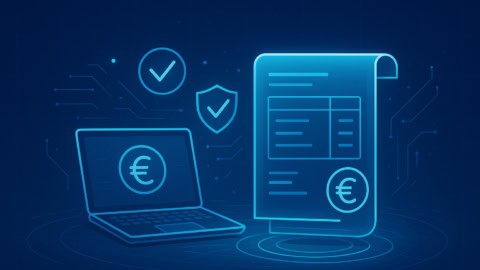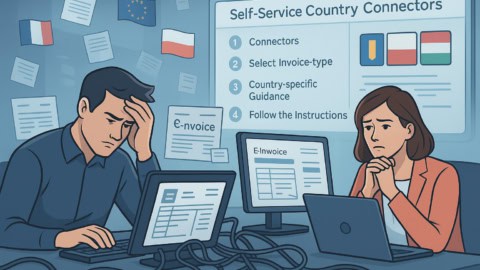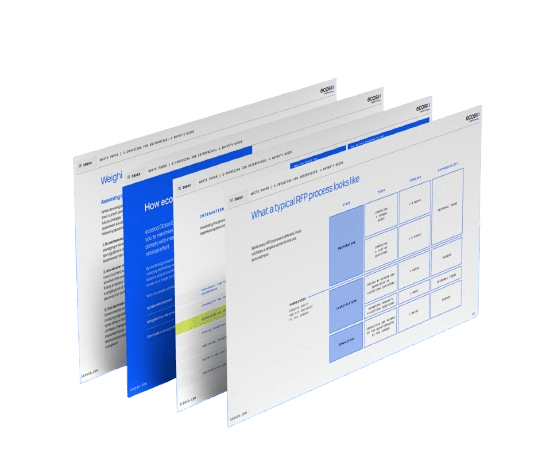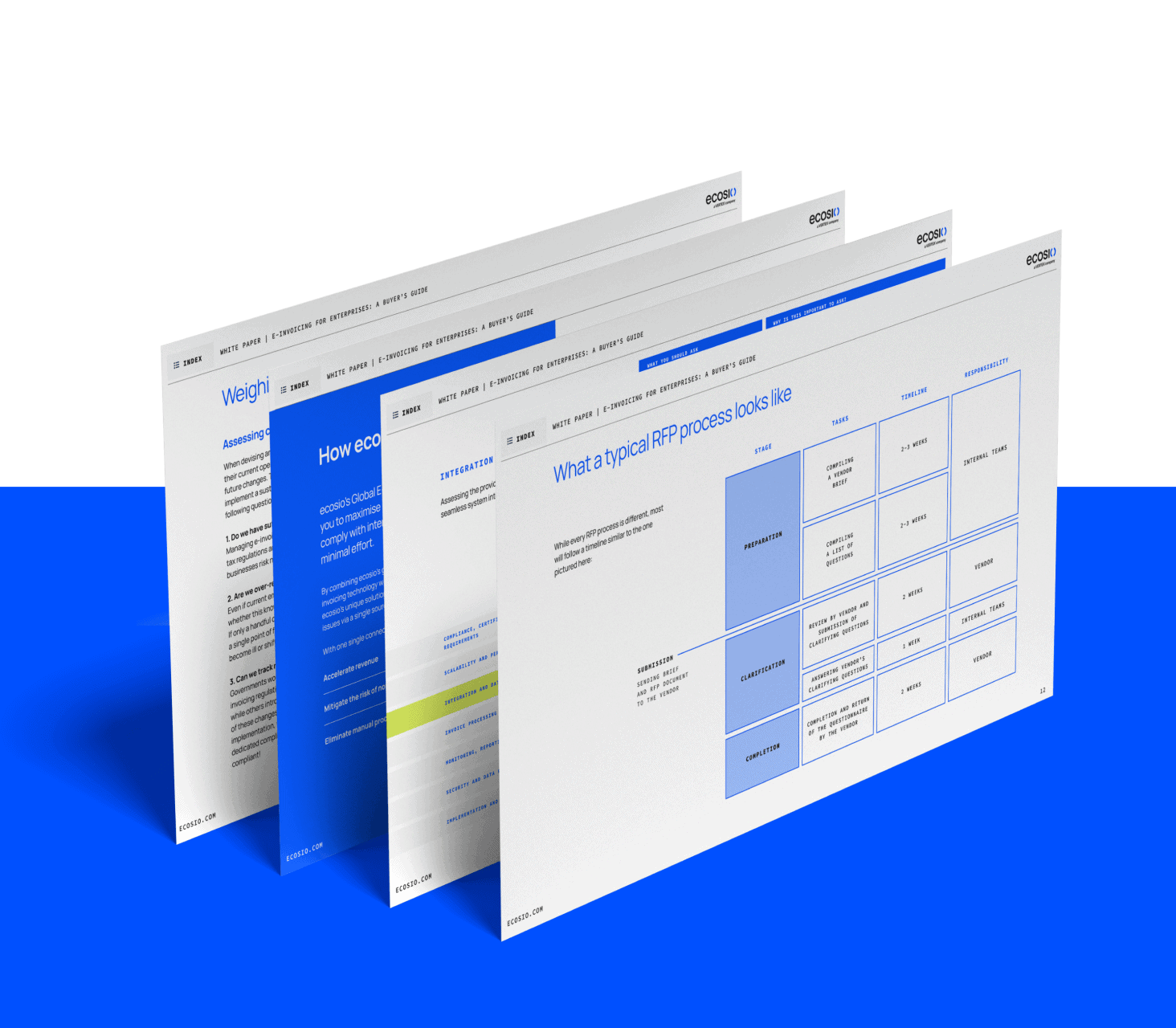E-invoicing in Peru is mandatory and fully regulated by the government. All electronic tax documents, known as Comprobantes de Pago Electrónicos (CPEs), must be issued in the UBL 2.1 XML format, digitally signed, and submitted for real-time validation by the tax authority SUNAT or an authorised OSE before they are considered legally valid.
🔍 TL;DR summary
- E-invoicing is mandatory for almost all taxpayers in Peru
- Documents must be generated in UBL 2.1 XML and digitally signed
- Validation occurs either directly with SUNAT or through an authorised OSE
- Supported documents include invoices, credit/debit notes, receipts (boletas) and transport guides (GRE)
- Taxpayers must keep both the XML and CDR for at least five years
- Businesses must decide which operating model fits their transaction volume and system capabilities best
Peru’s e-invoicing journey: how did we get here?
Peru implemented electronic invoicing in stages, beginning with large taxpayers in 2017 and expanding to progressively smaller segments. By 2022, the system covered nearly the entire taxpayer base.
This phased approach allowed businesses time to modernise, while enabling Peru’s tax administration, SUNAT, to build a highly automated, real-time reporting environment.
Why did Peru move to mandatory e-invoicing?
Peru has been one of Latin America’s early movers in digital tax transformation. Over the past decade, SUNAT has shifted the country from paper and PDF invoices toward a fully electronic system built on standardised, machine-readable documents known as Comprobantes de Pago Electrónicos (CPEs).
The motivations for this were clear: to modernise tax controls, improve data accuracy, reduce fraud, and create a more efficient invoicing ecosystem for businesses of all sizes. Today, electronic invoicing covers almost all economic activity in Peru, from large corporations to SMEs and micro-businesses.
What documents are supported?
Today, Peru’s e-invoicing applies across a wide range of tax documents, including:
- Invoices (facturas): for B2B and B2G transactions
- Receipts (boletas): for B2C transactions, with daily summary reporting
- Credit and debit notes: these must reference the original invoice
- Transport guides (GRE) (Guía de remisión): for most physical shipments
- Self-billed invoices (Liquidación de compra)
- Export invoices: these must be flagged with the correct operation type
- Withholdings (Retenciones)
- Collections (Percepciones)
All these documents are standardised under UBL 2.1 XML, enabling consistent processing across platforms.
The result is a tax ecosystem where both compliance and business processes can be streamlined, provided companies adopt the right technology.
How does Peru’s e-invoicing system work?
At the centre of the regime is SUNAT (Superintendencia Nacional de Aduanas y de Administración Tributaria). SUNAT is the tax authority responsible for defining formats, validating documents and managing the infrastructure. Businesses must generate and send their electronic documents in UBL 2.1 XML, digitally signed using an accredited certificate.
There are two main validation paths:
1. Direct submission to SUNAT
This method requires the company to maintain its own systems and certify compliance, which is why most businesses delegate validation to certified third-party providers.
2. Validation via an authorised PSE and/or OSE (service providers)
A PSE (Proveedor de Servicios Electrónicos) creates and sends your electronic documents after converting them in XML files, applies the digital signature, and transmits everything to SUNAT or an OSE.
The OSE (Operador de Servicios Electrónicos) validates invoices on SUNAT’s behalf and issues the Constancia de Recepción (CDR), confirming legal acceptance.
In both cases, the validated XML plus the CDR must be stored securely for at least five years.
Understanding the difference between PSE and OSE
| Provider | Full name | Primary role | Function |
|---|---|---|---|
| PSE | Proveedor de Servicios Electrónicos (Electronic Services Provider) | Document creation and sending | The PSE takes a business’s transaction data, converts it into the legally required UBL format, applies the digital signature, and sends the document. |
| OSE | Operador de Servicios Electrónicos (Electronic Services Operator) | Mandatory validation and certification | The OSE acts as a delegate of SUNAT. Its job is to check the document against over 100 rules for technical and legal validity before the invoice is considered final. They issue the official CDR (Constancia de Recepción). |
What are the technical requirements?
To stay compliant, businesses need:
- A digital certificate issued by a SUNAT-accredited provider (if you don’t work with a PSE)
- The ability to generate UBL 2.1 XML invoices and notes
- Integration with a PSE or direct connection to SUNAT/OSE endpoints
- A storage system for XML and CDR for at least five years
For high-volume issuers, working with an OSE + PSE combination is common, as it provides faster validation, additional redundancy, and operational insight.
How do Peru’s e-invoicing rules impact AR and AP teams?
Accounts receivable (AR)
Businesses must ensure their systems can generate compliant XMLs, apply the correct digital signatures, and transmit invoices reliably via their chosen model (OSE or direct).
Poor master data or mapping errors may lead to rejected CPEs, delaying collections and requiring resubmission.
Accounts payable (AP)
Businesses must be able to process XML files, verify SUNAT validation, and reconcile data back to purchase orders and goods receipts.
Daily summary reporting and document referencing rules (e.g. credit notes) also create new reconciliation touchpoints.
Want more information on e-invoicing in Peru?
For a technical overview of e-invoicing in Peru and a detailed list of all current requirements, please visit our dedicated of the current requirements, please visit our dedicated e-invoicing in Peru page.
If you have any specific questions, please also feel free to contact us. Our e-invoicing experts would be happy to walk you through what your business needs in order to stay compliant and prepare for future changes.
Frequently asked questions
Is there a specific legal format required for the CPEs?
Yes. All electronic documents in Peru must adhere to the UBL 2.1 schema.
Are digital signatures mandatory in Peru?
Yes. All CPE XMLs must be digitally signed using a SUNAT-accredited certificate.
Can an invoice be cancelled?
Yes. You must issue a Comunicación de Baja within seven days. SUNAT confirms cancellation with a CDR.
Who is responsible for issuing the GRE?
The party moving the goods. If a carrier is used, the carrier issues the GRE; otherwise, the seller does.
How long are we legally required to archive the electronic documents?
The obligation to archive documents depends on the taxpayer regime, but the general rule is that CPEs and their associated CDRs must be kept for a minimum of five years from the first day of the year following their issuance.
How can ecosio help businesses achieve worry-free compliance in Peru?
While Peru’s e-invoicing framework, known as Comprobantes de Pago Electrónicos (CPE), has matured under the tax authority SUNAT, its mandatory nature for all taxpayers, including the complexity of coordinating with authorised Electronic Service Operators (OSE), can still pose significant compliance risks.
ecosio ensures your data always matches the strict UBL 2.1 XML format and the latest SUNAT requirements through always-on monitoring and proactive updates.
With ecosio’s Global E-invoicing Compliance solution, you’ll benefit from worry-free compliance with a partner that:
- Manages the entire compliance process: ecosio’s experts handle the complex steps of generating the compliant XML, applying the digital signature, submitting it to the SUNAT platform for clearance, and managing the proof of receipt (CDR).
- Ensures format accuracy: ecosio’s solution automatically validates and converts your ERP data into the required UBL 2.1 XML format, ensuring you avoid rejections and associated fines.
- Provides real-time compliance: You receive real-time updates about regulatory changes, such as new reporting requirements or deadlines for platforms like SIRE, without needing to manually track legislative drafts.
Glossary of Peru e-invoicing abbreviations
| Abbreviation | Full Name | Role/Meaning |
|---|---|---|
| SUNAT | Superintendencia Nacional de Aduanas y de Administración Tributaria | The national tax and customs authority responsible for setting e-invoicing rules and infrastructure |
| CPE | Comprobante de Pago Electrónico | The general term for any electronic tax document in Peru (e.g. invoices, receipts, credit notes) |
| OSE | Operador de Servicios Electrónicos | An authorised third-party delegate of SUNAT that validates CPEs against legal rules and issues the official CDR |
| PSE | Proveedor de Servicios Electrónicos | An electronic services provider that generates the CPE XML, applies the digital signature, and transmits the document to the OSE or SUNAT |
| CDR | Constancia de Recepción | The proof of receipt or legal acceptance document issued by SUNAT or an OSE, confirming the CPE’s validity |
| GRE | Guía de Remisión Electrónica | The electronic transport guide, required for the legal movement of physical goods |
| SIRE | Sistema Integrado de Registros Electrónicos | A platform or system mentioned in the text for electronic reporting requirements (often related to VAT registries) |

























